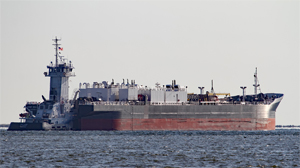Houston-based Kirby Corp., a nationwide tank-barge operator, will retire four of its coastal articulated tug-barge (ATB) units and has scrapped one leased barge to meet the U.S. Coast Guard’s ballast water regulations. The move comes as the world’s maritime authorities try to stop the transfer of invasive species.
“An analysis of our fleet revealed that we couldn’t recover the installation cost of ballast water treatment systems for these four ATBs, given their short remaining life and the current economic environment for coastal barging,” Eric Holcomb, Kirby’s vice president of investor relations, said in late February.
Under an International Maritime Organization convention effective in September 2017, 80 nations have agreed to control ballast water to reduce the transfer of organisms and pathogens. The United States isn’t a signatory to this Ballast Water Management Convention, however, and has its own standard. The Coast Guard regulates ballast water treatment in the U.S.
“The regulations require that systems be installed on a vessel’s next major dry-docking or survey date, so our retirements will vary depending on when each vessel was placed into service,” Holcomb said. For the four ATBs to be retired, their upcoming major dry-dock dates are from 2020 to 2023. “Our leased barge was scrapped earlier this year,” he said.
All of Kirby’s retirements will be coastal barges. “Inland barges don’t use ballast water, given their small size of 30,000 barrels or less,” Holcomb said. “Generally, vessels using ballast water are around 80,000 barrels or greater.” The barges Kirby plans to retire exceed 80,000 barrels.
Invasive “hitchhiking” in ships’ ballast has grown as global trade increases. Under the National Invasive Species Act of 1996, the Coast Guard in 2004 established rules for controlling the discharge of organisms from ballast in U.S. waters. Those Coast Guard rules, 33 CFR Part 151 and 46 CFR Part 162, have been in effect since mid-2012.
The Coast Guard required compliance with its treatment standard at a vessel’s first scheduled dry-docking after Jan. 1, 2016. But owners were given extensions because of a lack of approved market-ready systems at that time. By February of this year, however, the Coast Guard had certified 16 types of ballast management systems, and owners are now less likely to receive extensions.
“Installations of ballast water treatment systems on our other vessels will be completed at a major shipyard of our choice,” Holcomb said. “We don’t disclose the vendors we use. And we haven’t disclosed the cost to install these systems.” The cost is determined by a vessel’s size and design and the treatment system used.
According to the Coast Guard, compliance methods in the U.S. include the use of a Coast Guard-approved ballast water management system; discharge of water to an onshore facility or another vessel for treatment; using water from a U.S. public system; or not discharging ballast water within U.S. boundaries.
Among the invaders transported in ballast water are Australian spotted jellyfish, seen around Hawaii since the 1940s. They’ve clustered off California since the 1980s and in the Gulf of Mexico since 2000, harming shrimp and clogging fishing nets.
In Kirby’s Jan. 31 fourth-quarter report, the company said it would spend about $25 million for coastal ballast water treatment systems in 2019. In the report, Kirby CEO David Grzebinski said the company’s coastal barge use in percentage terms is expected to improve to the low- to mid-80s this year due to “stable to slightly improving” customer demand in addition to the barge retirements to meet ballast rules.
Kirby’s coastal fleet includes 53 tank barges and 50 tugboats. Offshore, the company operates four dry-bulk cargo barges, four tugboats and one docking tugboat. Its inland fleet includes 1,003 tank barges and 285 towboats.
As of late February, Kirby had not disclosed whether it would replace the retired ATBs.

